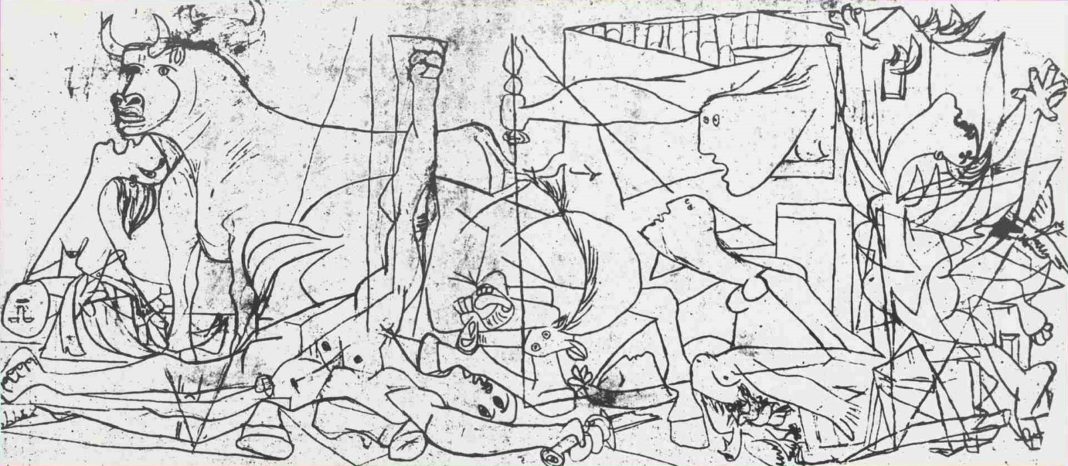The exhibition “Salud – Picasso Speaking. ‘Guernica’ and the War in the Cities” picks up traces and strands of the (art) stories associated with Picasso and relates them to current conflicts. The exhibition is being shown at the station urbaner kulturen, organised by the nGbK – neue Gesellschaft für bildende Kunst.
Fig. above: Exhibition poster Kunat and Pofitik using Guernica as an example, 1975 © Succession Picasso, VG Bild-Kunst Bonn, 2022 and nGbk.
An international war was raging in Europe and the Spanish-French artist Pablo Ruiz Picasso reacted with the monumental painting Guernica. The famous dove of peace, which Brecht used unasked as a curtain motif for the Berlin Ensemble in 1953, followed later. Beyond the doves of peace, however, the “formalist” Picasso was suspect to the GDR authorities. The theatre curtain remained in use until 1993 and was last pulled out once more on the occasion of the Russian invasion of Ukraine.
Some of these stories were recently recalled in the extraordinary exhibition The Picasso Divided at the Museum Ludwig. The Cologne presentation also included the 1975 NGBK (since 2012 nGbK) wall show Art and Politics in Guernica. Picasso and the Spanish Civil War: This subsequently travelled through numerous West German schools, cultural centres and even as far as the Venice Biennale. And it was reflected in a WDR television report where young people at a comprehensive school dreamed of more peaceful times. The “didactic exhibition” railed against the crimes of the Wehrmacht and analytically dissected the panoramic image of Guernica into meaningful individual parts. The connection of the West Berlin left to the GDR went beyond the spatial reference of the NGBK on the Kreuzberg border to East Berlin.
The title of the current exhibition Salud – Picasso Speaking quotes the artist as saying that in December 1937, in his symbolic role as director of the Prado Museum, he picked up the phone to call on the Second American Artists Congress (AAC) in New York to show solidarity with the international resistance against Franco, Hitler and Mussolini in the midst of the Spanish Civil War. In 1939, the AAC managed to bring Guernica to New York to raise money to support Spanish refugees. After further travels, the painting ended up at MoMA until it was transferred back to a democratic Spain in 1981.
The artist, who had been exiled from Franco’s fascism and had long been stateless and without rights in France, joined the Communist Party in 1944. Picasso maintained links with the illegal Spanish CP and donated a lot of money to the comrades. While he rarely left his studios, he was always present at the peace congresses in Rome, Moscow or Sheffield. However, the “divided Picasso” never travelled to the successor states of the German Reich.
Salud – Picasso Speaking. ‘Guernica’ and the War in the Cities brings together materials and stories in an exhibition about an exhibition about exhibitions. Berlin-based Israeli-German artist Eran Schaerf will join curator Julia Friedrich (Museum Ludwig Cologne, now Jewish Museum Berlin) to recall their Picasso project in Cologne. Picasso’s unique and ambivalent role as a global artist with a posthumous exploitation industry attached to him will be the subject of a sound work by the Berlin-based Russian artist Mikhail Lylov and the Ukrainian artist Dana Kavelina together with David Riff and Guglielmo Piva.
Artistic contributions: Mikhail Lylov and Dana Kavelina with David Riff and Guglielmo Piva, Eran Schaerf
Exhibition design: Madeleine Stöber
WHERE?
station urbaner kulturen, Auerbacher Ring 41, 12619 Berlin
WHEN?
Thursday, 15 September 2022 until Saturday, 14 January 2023
COST?
Free admission






